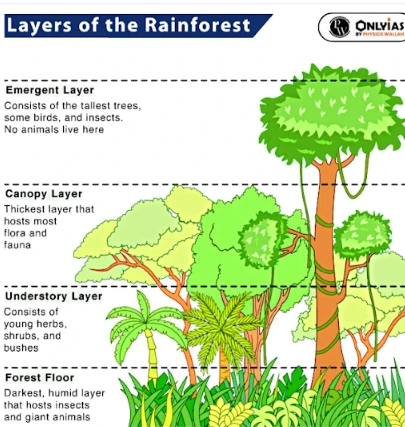|
Tropical Rainforest: Nature’s Green Treasure & Economic Significance |
Tropical Rainforest: Biodiversity and Ecological Importance
The tropical rainforest is one of the Earth’s most diverse ecosystems, known for its lush vegetation, abundant wildlife, and vital role in maintaining the planet’s ecological balance. Scientists estimate that over 50% of the Earth’s plant and animal species are inhabited in tropical rainforests. These ecosystems are responsible for generating approximately 40% of the planet’s oxygen.
Tropical Rainforest: Exploring the Biodiversity and Wonders of Tropical Ecosystems
- They are the most lush green forest with a wide variety of communities and constitute one of the biggest biomes on the planet.
- Distribution: Found in wet tropical uplands and lowlands around the Equator.
- These rainforests are abundant near the equator in regions of Central and South America, Africa, Southeast Asia, and Oceania.
- Abiotic Components: Exploring Abiotic Components of Tropical Rainforests
- Humidity: Experience high humidity and high temperature (more or less uniform).
- PrecipitationThe rainfall often exceeds 100 inches (250 cm) with evenly distributed throughout the year.
- This consistent warmth and moisture provide ideal conditions for plant growth and biodiversity.
- Soil Type: The predominant soil types in tropical rainforests are oxisols and ultisols.
- These soils are rich in iron and aluminum oxides, giving them a reddish color.
- Tropical rainforest soil is generally nutrient-poor with a high rate of leaching which makes it agriculturally useless.
- Heavy rainfall in these areas results in the washing away of crucial nutrients from the soil.
- But the soil can rejuvenate with nutrients when left undisturbed.
- Leaf Litter: One of the distinctive features of rainforest soil is the thick layer of leaf litter and organic matter that accumulates on the forest floor.
- This organic material decomposes rapidly due to the warm and humid conditions, contributing to the recycling of nutrients.
- Biotic Components: A Closer Look at Flora and Multilayered Vegetation
- Flora: The Lush Multi Layered Vegetation
- The dense vegetation of tropical rainforests includes towering trees, vibrant flowers, and a wide array of plant species.
- There is presence of both a dense upper canopy and a thick undergrowth.
- This multi-layered structure allows various plants to thrive at different heights.
- Algae, liverworts, creepers, ferns, mosses, and lichens are also present.
- Flora: The Lush Multi Layered Vegetation
-
- Fauna: Biodiversity and Endemic Wonders
- These forests support a wide range of animals, including mammals, birds, reptiles, and amphibians.
- Iconic species like jaguars, toucans, tree frogs, and pythons are present.
- Insects and microbial life are abundant which play an essential role in nutrient cycling and ecosystem functioning.
- Many species in these rainforests are endemic, meaning they are found exclusively in specific rainforest regions.
- Fauna: Biodiversity and Endemic Wonders
Distinctive Features of Tropical Rainforest: Layers of Life
- These forests’ vegetation exhibits a layered structure.
- Each Layer has distinct features depending on varying levels of water, sunshine, and air movement.
- Four-layered structure: Tropical forest’s vegetation exhibits a four-layered structure which are as following-
- Emergent Layer: The trees that dominate the skyline and reach heights of up to 60 meters are found in this uppermost layer.
- Small waxy leaves on trees in the emergent layer help them retain water during prolonged droughts or dry seasons.
- Their seeds are little and easily swept away by the wind.

- Canopy Layer: It is a deep layer of vegetation that is around 6 meters thick and lies under the emergent layer.
- It lies over the other two remaining layers.
- It forms a dense network of leaves and branches and creates a roof to keep out the sun, rain, and winds.
- As a result, the ground underneath becomes damp, sluggish, and gloomy.
- Understory Layer: This layer, which lies under the canopy layer, is darker, stiller, and more humid than the canopy layer.
- To capture the minimal sunlight that penetrates below the thick canopy, plants in this tier have broader leaves.
- Forest Floor Layer: It is the lowest layer of the rainforest and is also known as the “shrub layer.”
- It is the darkest layer which makes it very difficult for plants to thrive.
Economic Importance of Tropical Rainforests: Valuable Resources and Environmental Stewards
- Timber: Rainforests are a major source of valuable timber, including hardwoods like mahogany, teak, and rosewood.
- Agriculture: These regions are suitable for agriculture, and many tropical crops like cocoa, coffee, rubber, and palm oil are grown in these areas
- Pharmaceuticals: Rainforests have rich biodiversity with many plant species having medicinal properties which led to the development of pharmaceuticals.
- Carbon sequestration: Rainforests play a crucial role in regulating the Earth’s climate. They absorb and store carbon dioxide, helping to mitigate climate change.
Tropical Rainforest: Balancing Economic Gains with Conservation Imperatives
- The economic benefits of tropical rainforests must be balanced with conservation efforts and sustainable practices to ensure the long-term viability of these ecosystems.
|
Previous Year Questions (Prelims) Q. If a tropical rainforest is removed, it does not regenerate quickly as compared to a tropical deciduous forest. This is because_(2011)
Answer. (A) Q. Consider the following statements: (2011)
Which of the statements given above is/are correct?
Answer. (C) |































